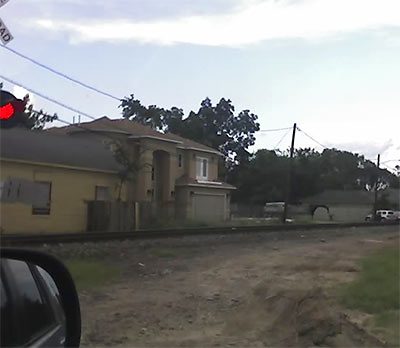Tag: Transportation
HISTORY IN THE MAKING A whole lotta railroad action next to the site of the planned Crawford Stations on the East End line, between Minute Maid Park and Discovery Green — but will this train be rolling?: “If a series of deals go through, the city would be able to create a ‘super block’ previously eyed for a new hotel, redevelop Avenida De Las Americas and move two historic houses and a railroad engine to create a small historic area on the eastern side of downtown. The train would complement the homes and proposed heritage center — which would be paid for with privately raised funds — and underscore the importance of locomotives in Houston’s history in facilities across the street from the former Union Station. . . . But the plans also call for an unusual process to sell land to a wealthy, well-connected real estate investor and former council member, and force the city to move the historic homes.. . . Several City Council members raised questions about the initial step in the process, which the council will consider today, to appoint an independent appraiser to name a price for the land on Avenida De Las Americas, between Capitol and Rusk. If the city sees the price as favorable and decides to sell, it would then be up to Louis Macey, who owns a far larger piece of land that abuts the area, to buy. . . . Andy Icken, deputy director of the city’s Department of Public Works and Engineering, said the city needs to relocate the homes before the Metropolitan Transit Authority begins building light rail lines along Capitol and Rusk. . . . The city has chosen to sell the houses through a process normally used with abandonments because it is likely to get more money that way, he said. By itself the land’s potential may be limited, but if an appraiser can consider its value in the context of other downtown land — which is possible in this case because Macey is the adjacent landowner — it is almost certain to fetch a higher price, he said.” [Houston Chronicle]
COMMENT OF THE DAY: BRING YOUR MUD BOOTS “There are too many high-speed arterials, especially outside the Loop, with no sidewalks. I was taking the bus to work for about a month earlier this year (I work in an office on the North beltway). There are bus stops there but no sidewalks. Speeds on the feeder road tend to be 45 to 50 mph. There are few pedestrians (for obvious reasons) but there are some; bus commuters like me, kids walking to school every day, etc. They will walk on muddy paths to avoid walking in the street. And bus riders with wheelchairs or strollers are simply SOL. I liked riding the bus, but not the sidewalk-free walk at the end of the ride.” [RWB, commenting on Where the Sidewalks End]
WHERE THE SIDEWALKS END “On Airline Drive, for example, up to 40,000 people arrive every weekend to visit flea markets that line both sides of the road. The neighborhood’s management district is gearing up to spend $2.9 million on pedestrian improvements, including two new, signalized crosswalks on Airline, as well as sidewalks on nearby streets that are heavily used by local residents. . . . [Harris County] has a policy of not installing sidewalks when it builds a new road, unless a group or city provides the extra money. ‘It’s an expense that doesn’t have to do with transportation,’ said Mark Seegers, a spokesman for Harris County Commissioner Sylvia Garcia. ‘The county does not do sidewalks; it’s not what gets cars from point A to point B.’ . . . In the eight-county region that includes Houston, an average of 100 pedestrians died every year between 2003 and 2008, and an average of 1,175 were injured, mostly within Harris County, according to statistics compiled by the Texas Department of Transportation. More than half of all pedestrian deaths occur on [high-capacity, high-speed roads called ‘arterials’], often as people are trying to cross to reach retail shops or bus stops.” [Houston Chronicle]
- Clip: Houston à Vélo [Vimeo]
Video: Aubin Malassagne; music: Le Comte de Fourques
PAYING TOLLS ON I-45, 290, AND 59 “At its October meeting, the Metro board gave the go-ahead for the future conversion of highway HOV lanes to so-called “HOT†lanes (high-occupancy toll) like the ones operating on the Katy Freeway. A HOT lane has electronic scanning equipment that allows a solo driver to pay a toll to use a segregated carpool lane during rush hours. . . . The conversion of HOV lanes will occur on five freeway segments in the Metro service area: I-45 North and South, U.S. 290, and U.S. 59 north and south. Board documents indicate the cost of installing toll readers and automated gates would be about $48 million. Operating and maintaining the system for five years would cost an additional $42 million. Four-fifths of the total will come from federal grants. Metro will release more information when the final contract is signed, [Metro spokeswoman Raequel] Roberts said. But she said the HOV conversions could be completed in about two years.” [Houston Chronicle, via BlogHouston]
LITTLE GRAND PARKWAY ON THE PRAIRIE NOT SO SHOVEL-READY AFTER ALL Those pesky federal regulators, ruining all the fun: It’s now looking like the 15-mile-long Upper Katy Prairie paving project known as the Grand Parkway Segment E won’t be getting the bucket of cash Harris County Commissioners Court wanted. County officials will instead request that the $181 million in federal stimulus funds earlier allocated to the way-out-northwest loop road be distributed to other projects: “The recommendation to withdraw the project from the Texas Department of Transportation’s list of stimulus projects was made by Art Storey, who heads Harris County’s Public Infrastructure Department. Storey declined to comment on his recommendation until it is considered at Harris County Commissioner Court’s meeting next Tuesday. ‘Staff and consultants have worked diligently and successfully to be on schedule to meet the deadlines to enable Segment E construction to qualify for and receive the stimulus funding, but the federal permit from the U.S. Army Corps of Engineers cannot be completely processed by the required mid-February date,’ Storey said in a letter to the court. ‘In fact, because of conflicts over environmental impacts and mitigation, that permit might never be issued.’” [Houston Chronicle; previously on Swamplot]
METRO JUST MEANS AFTERPARTIES ARE OUT OF THE QUESTION On the way to asking a larger political question, a personal testament to the moderating influence of going car-free: “See, in the past month I’ve had absolutely no problems getting to where I want to go. I can grab groceries, visit friends. The other day I took my primary romantic interest to dinner and a movie. We hopped a few buses to the Marq*E, headed back across town on a 20-Long Point to Ninfa’s/Navigation, then grabbed two buses back to her place. Thing is, it was a 3:30pm movie. You can get anywhere on the bus, but you have to do it *early*, because if you stay out too late the buses stop running. Transit doesn’t alter your mobility, it alters your lifestyle. I can hop a 40-Telephone and grab some extra-large CFS at the Dot Coffee Shop. But I can’t do it at 3am. I can catch a 25-Richmond to the drum and bass night. But to get home will require an expensive cab ride, unless I jet the party when other people are still showing up. Basically, transit has an incredible power to make you square.” [Keep Houston Houston]
SECRET POWERS OF THE CORDELL ST. SHIPPING-CONTAINER HOUSE The Brookesmith home of Kevin Freeman and Jen Feldmann — fashioned from shipping containers by Numen Development’s John Walker and Katie Nichols — meets a national audience in the pages of the latest issue of Dwell: “The meat distributor [across Cordell St.] begins loading trucks as early as 5:30 a.m., but the couple imagines themselves as hipsters living in New York City’s meatpacking district, and that makes it okay. . . . The corrugated steel of the container that houses the master suite becomes a textured wall for writing messages in the home’s entrance. ‘When we were furnishing the house, I thought, “Oh no! Our fridge isn’t magnetic for Eli’s artwork,” but then I realized the whole house is magnetic,’ Feldmann says. ‘We’ve become magnet connoisseurs,’ Freeman adds.” [Dwell; previously in Swamplot]
THE PATH OF COMMUTER RAIL Which area freight rail routes might share their tracks with commuter rail lines? Probably not the Union Pacific line along U.S. 90A to Sugar Land. “But two other freight lines have less traffic, and Union Pacific is working with government planners to free them up for commuter trains. One runs out the U.S. 290 corridor and one runs along Texas 3 to Galveston. TxDOT is considering granting $2 million in stimulus funds for two engineering studies on those routes. ‘My goal is to have trains running in three years,’ said Harris County Judge Ed Emmett. The engineering studies will design routes that bring suburban commuters to the 610 Loop, but no farther. The freight traffic inside the Loop is still too busy, and although there is an abandoned rail line, it runs right through the Heights — a politically vocal neighborhood. ‘That’s not something I want to take on,’ said Emmett. The compromise is to build some commuter lines now, connect them to light rail or bus lines, and figure out later how to get them inside the Loop, to downtown.” [Houston Chronicle]

A reader sends in this photo, wanting us to
check out this newly built house in the first ward. On the dirt road aka Winter st. just east of White.
Who would build a house with the train running through their front yard?1?
Only in Houston.
Photo: Swamplot inbox

How’s the street surfing in your neighborhood?
Photo: Flickr user jarrod-drew, via The High on the Hog Blog
TAKING THE “A” STREETS: NEW RULES FOR HOUSTON’S RAIL TRANSIT CORRIDORS Does your street intersect one of the new light-rail lines within a quarter-mile of a proposed station? If so, it’s now called an “A” Street, and the Urban Corridors Ordinance, which City Council approved yesterday, has some new development restrictions and exemptions that affect it, effective immediately: “The ordinance will mandate six-foot sidewalks near stations while increasing the citywide sidewalk standard from four feet to five feet. The ordinance creates an incentive program to entice developers to build more livable, walkable, and urban places. In return, the developers will be exempted from the 25-foot setback required in the rest of the city, allowing them to build on a greater percentage of land.” [Houston Tomorrow]
How’s business going for that new emission-free all-electric text-us-and-we’ll-pick-you-up sorta-free Downtown shuttle service?
A little more than a year into it, REV Houston’s 3 Chrysler GEM vehicles are proving quite popular with . . . city investigators!
City officers have ticketed Rev Houston drivers at least 15 times this year, and plenty more last year. The citations, which average $150 to $200, are for offenses such as “no taxicab permit†and “no taxicab driver’s license.â€
“One of the offenses is ‘no fire extinguisher,’ †Ibarra said. “Our vehicles don’t have a single drop of combustible liquid, but the city feels we need to have a fire extinguisher. ‘No taxi meter’ is another one. We don’t charge a fare, so why should we have a taxi meter?â€
Tina Paez, the city’s deputy director of administration and regulatory affairs, said Ibarra’s vehicles have been cited as taxis because they take passengers.
“If they charge a fare or accept a gratuity, they are a vehicle for hire,†she said. “Even though they don’t technically charge, they come under the ordinance.â€
- His ‘green’ venture is costing a bit of green [Houston Chronicle, via Off the Kuff]
- REV Houston
- Previously on Swamplot: REV Houston: Street Illegal, Tips Only: Downtown-to-Midtown Zero-Emission Shuttle
WHERE COMMUTER RAIL MIGHT COME FROM “We may have commuter rail to Galveston and Hempstead as early as 2012,” declares rail watcher Christof Spieler. So who’s gonna make it happen? How about . . . the Gulf Coast Freight Rail District? “The GCFRD just advertised for and received qualifications for firms to do $2 million in engineering studies, to be completed by June 2010, for 90 mph commuter rail lines sharing freight rail tracks along 290 from Hempstead to just inside 610 and from Galveston to just inside 610. This spring, the Texas Legislature expanded GCFRD’s mission to include intercity passenger rail; despite its name, the district has already been empowered to build commuter rail. Waller and Galveston counties are now joining the GCFRD, making the district the only entity short of TxDOT that covers both of those lines.” [Intermodality]

